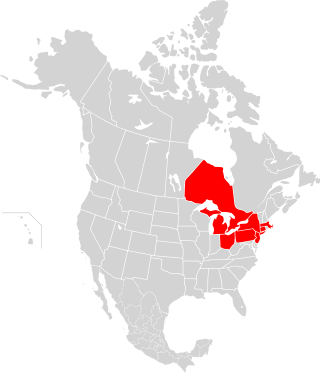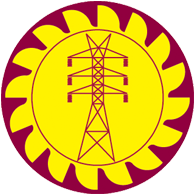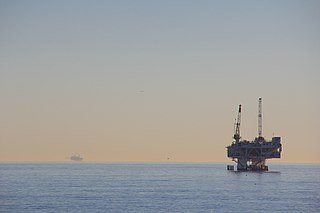Related Research Articles
An energy crisis or energy shortage is any significant bottleneck in the supply of energy resources to an economy. In literature, it often refers to one of the energy sources used at a certain time and place, in particular, those that supply national electricity grids or those used as fuel in industrial development. Population growth has led to a surge in the global demand for energy in recent years. In the 2000s, this new demand – together with Middle East tension, the falling value of the US dollar, dwindling oil reserves, concerns over peak oil, and oil price speculation – triggered the 2000s energy crisis, which saw the price of oil reach an all-time high of $147.30 per barrel ($926/m3) in 2008.

A rolling blackout, also referred to as rota or rotational load shedding, rota disconnection, feeder rotation, or a rotating outage, is an intentionally engineered electrical power shutdown in which electricity delivery is stopped for non-overlapping periods of time over different parts of the distribution region. Rolling blackouts are a last-resort measure used by an electric utility company to avoid a total blackout of the power system.

The Northeast blackout of 2003 was a widespread power outage throughout parts of the Northeastern and Midwestern United States, and most parts of the Canadian province of Ontario on Thursday, August 14, 2003, beginning just after 4:10 p.m. EDT.

The utility electricity sector in Bangladesh has one national grid operated by Power Grid Company of Bangladesh with an installed capacity of 25,700 MW as of June 2022. Bangladesh's energy sector is not up to the mark. However, per capita energy consumption in Bangladesh is considered higher than the production. Electricity was introduced to the country on 7 December 1901.

The Ceylon Electricity Board - CEB, was the largest electricity company in Sri Lanka. With a market share of nearly 100%, it controlled all major functions of electricity generation, transmission, distribution and retailing in Sri Lanka. It was one of the only two on-grid electricity companies in the country; the other being Lanka Electricity Company (LECO). The company earned approximately Rs 204.7 billion in 2014, with a total of nearly 5.42 million consumer accounts. It was a government-owned and controlled utility of Sri Lanka that took care of the general energy facilities of the island. The Ministry of Power and Energy was the responsible ministry above the CEB. Ceylon Electricity Board (CEB), established by the CEB Act No. 17 of 1969, was under the legal obligation to develop and maintain an efficient, coordinated and economical system of electricity supply in accordance with any licenses issued. The CEB was dissolved and replaced by 12 successor entities under the 2024 Electricity Act.

The 2011 Southwest blackout, also known as the Great Blackout of 2011, was a widespread power outage that affected the San Diego–Tijuana area, southern Orange County, Imperial Valley, Mexicali Valley, Coachella Valley, and parts of Arizona. It occurred on Thursday, September 8, 2011, beginning at about 3:38pm PDT, and was the largest power failure in California history.

Energy in Lebanon is characterized by a heavy reliance on imported fuels, which has led to significant challenges in ensuring a stable and sufficient supply of electricity. The country’s energy sector has been severely affected by a combination of internal political instability, external conflicts, and systemic corruption. The reliance on imported energy, coupled with rising demand and frequent infrastructure failures, has led to an ongoing energy crisis. This crisis has been further exacerbated by the destructive effects of military conflicts involving Hezbollah, particularly the wars against Israel and the war in Syria, which have strained the country's infrastructure and economy.

Two severe power outages affected most of northern and eastern India on 30 and 31 July 2012. The 30 July 2012 blackout affected over 400 million people and lasted about 13.5 hrs. During that period, it was the largest power outage in history by number of people affected, beating the January 2001 blackout in Northern India. Similar conditions caused a blackout on the next day, which remained the largest power outage in history as of June 2024. The outage affected more than 620 million people, spread across 22 states in Northern, Eastern, and Northeast India. An estimated 32 gigawatts of generating capacity was taken offline. Of the affected population, 320 million initially had power, while the rest lacked direct access. Electric service was restored in the affected locations between 31 July and 1 August 2012.

Energy is a major area of the economy of California. California is the state with the largest population and the largest economy in the United States. It is second in energy consumption after Texas. As of 2018, per capita consumption was the fourth-lowest in the United States partially because of the mild climate and energy efficiency programs.

Électricité du Liban is a public industrial and commercial establishment in Lebanon which controls 90% of the country's electricity production, transmission and distribution activities.

South Africa's energy crisis is an ongoing period of widespread national blackouts of electricity supply. It began in the later months of 2007 towards the end of Thabo Mbeki's second term as president, and continues to the present. The South African government-owned national power utility, and primary power generator, Eskom, and various parliamentarians attributed these rolling blackouts to insufficient generation capacity.

Nationwide recurring electrical blackouts in Venezuela began in March 2019. Experts and state-run Corpoelec sources attribute the electricity shortages to lack of maintenance and to a lack of technical expertise in the country resulting from a brain drain. Nicolás Maduro's administration attributes them to sabotage. Since March, various nationwide blackouts occurred in the country.

In February 2021, the state of Texas suffered a major power crisis, which came about during three severe winter storms sweeping across the United States on February 10–11, 13–17, and 15–20. The storms triggered the worst energy infrastructure failure in Texas state history, leading to shortages of water, food, and heat. More than 4.5 million homes and businesses were left without power, some for several days. At least 246 people were killed directly or indirectly, with some estimates as high as 702 killed as a result of the crisis.
The 2021–2022 global energy crisis has caused varying effects in different parts of the world.
The 2024 Lebanon blackout is an ongoing total nationwide power outage across Lebanon that began on 17 August 2024 due to the state electricity company of Lebanon, Électricité du Liban, running out of fuel reserves for its power plants. The blackout led to widespread water shortages due to the inability of Lebanese water corporations to pump water in effective amounts, as well as the halting of several fundamental institutions across Lebanon, including, wastewater treatment systems, ports, airports, and prisons.
A series of interruptions to the nationwide electrical service of Cuba occurred during the months of February, March, October and December 2024. The blackouts began in February 2024 with power outages that affected nearly half of the country. In March, further blackouts caused widespread protests. On 5–6 October, a third of the country experienced outages. From 18 to 22 October 2024, a total nationwide blackout occurred due to the failure of the Antonio Guiteras Power Plant. During the October shutdowns, the Cuban government announced energy-saving measures. The blackouts were the most severe living crisis that the country has experienced since the dissolution of the Soviet Union in 1991.

Despite being a country with huge oil and gas reserves Iran suffers from a severe energy crisis. The Iranian energy crisis is a multifaceted problem that has been exacerbated by a combination of factors, including bad governance, foreign policy failures, and the dominance of industries under the Islamic Revolutionary Guard Corps (IRGC). As of November 2024 Iran faces its most severe energy crisis in decades, with frequent power outages and disruptions to natural gas supplies. The country's energy infrastructure is outdated and in disrepair, with many refineries and power plants operating below capacity. Iran's energy supply is unreliable, with frequent blackouts and shortages affecting daily life, industries, and essential services. The IRGC's control over key industries, including power generation and distribution, has hindered efficient management and strategic planning. The regime's prioritization of political and economic interests over efficient management and infrastructural development has exacerbated the crisis.
The 2023-2024 Ecuador electricity crisis was caused by a severe drought that depleted water levels at hydroelectric plants and a lack of capacity buildup. Ecuador experienced rolling blackouts for up to 14 hours per day in the fall crisis of 2024. Researches describe fall 2023 and spring 2024 crises as separate events. The President of Ecuador Daniel Noboa had announced on 10 December, 2024 that the outages will end on December 20.

According to the International Energy Agency in 2022 almost all electricity was generated from oil and fossil gas, like energy in Syria. But according to Anadolu Agency as of 2024 most generation is hydro. In 2024 electricity grids needed war damage to be repaired. As of 2024 generation by power stations in Syria cannot meet demand, resulting in power cuts and air pollution from small diesel generators. As the country has plenty of sunshine solar power could be expanded.
References
- 1 2 3 4 "Lebanon left without power as grid shuts down". BBC News. 2021-10-09. Retrieved 2021-10-10.
- ↑ "Lebanon's national electricity grid collapses". Washington Post. ISSN 0190-8286 . Retrieved 2021-10-10.
- ↑ "Fuel shortage forces shutdown of Lebanon's main power plants". NBC News. Associated Press. Retrieved 2021-10-10.
- ↑ "Lebanese power outage will last for several days - government official". Reuters. 2021-10-09. Retrieved 2021-10-10.
- ↑ "Lebanon to receive $100 million to import fuel amid electricity crisis". The Jerusalem Post | JPost.com. Retrieved 2021-10-10.
- ↑ "Lebanon electricity back online after army supplies fuel". www.aljazeera.com. Retrieved 2021-10-11.